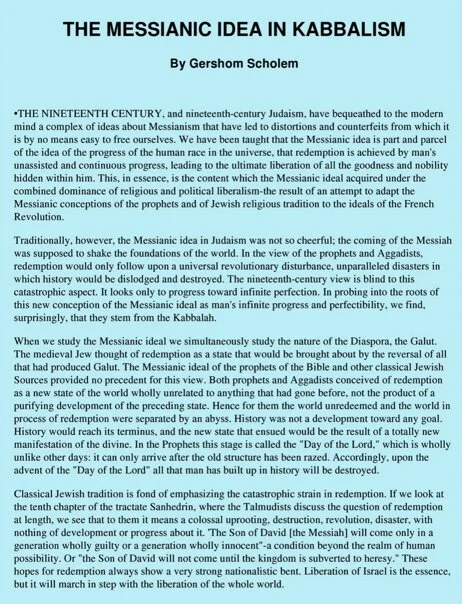THE MESSIANIC IDEA IN KABBALISM
By Gershom Scholem
THE NINETEENTH CENTURY, and nineteenth-century Judaism, have bequeathed to the modern mind a complex of ideas about Messianism that have led to distortions and counterfeits from which it is by no means easy to free ourselves.
We have been taught that the Messianic idea is part and parcel of the idea of the progress of the human race in the universe, that redemption is achieved by man's unassisted and continuous progress, leading to the ultimate liberation of all the goodness and nobility hidden within him.
This, in essence, is the content which the Messianic ideal acquired under the combined dominance of religious and political liberalism-the result of an attempt to adapt the Messianic conceptions of the prophets and of Jewish religious tradition to the ideals of the French Revolution.
Traditionally, however, the Messianic idea in Judaism was not so cheerful; the coming of the Messiah was supposed to shake the foundations of the world. In the view of the prophets and Aggadists, redemption would only follow upon a universal revolutionary disturbance, unparalleled disasters in which history would be dislodged and destroyed.
The nineteenth-century view is blind to this catastrophic aspect. It looks only to progress toward infinite perfection. In probing into the roots of this new conception of the Messianic ideal as man's infinite progress and perfectibility, we find, surprisingly, that they stem from the Kabbalah.
When we study the Messianic ideal we simultaneously study the nature of the Diaspora, the Galut. The medieval Jew thought of redemption as a state that would be brought about by the reversal of all that had produced Galut.
The Messianic ideal of the prophets of the Bible and other classical Jewish Sources provided no precedent for this view. Both prophets and Aggadists conceived of redemption as a new state of the world wholly unrelated to anything that had gone before, not the product of a purifying development of the preceding state.
Hence for them the world unredeemed and the world in process of redemption were separated by an abyss. History was not a development toward any goal. History would reach its terminus, and the new state that ensued would be the result of a totally new manifestation of the divine.
In the Prophets this stage is called the "Day of the Lord," which is wholly unlike other days: it can only arrive after the old structure has been razed. Accordingly, upon the advent of the "Day of the Lord" all that man has built up in history will be destroyed.
Classical Jewish tradition is fond of emphasizing the catastrophic strain in redemption. If we look at the tenth chapter of the tractate Sanhedrin, where the Talmudists discuss the question of redemption at length, we see that to them it means a colossal uprooting, destruction, revolution, disaster, with nothing of development or progress about it.
"The Son of David [the Messiah] will come only in a generation wholly guilty or a generation wholly innocent" a condition beyond the realm of human possibility. Or "the Son of David will not come until the kingdom is subverted to heresy." These hopes for redemption always show a very strong nationalistic bent. Liberation of Israel is the essence, but it will march in step with the liberation of the whole world.
Tisha b‘av information is here.
L'IDÉE MESSIANIQUE DANS LE KABBALISME
Par Gershom Scholem
Le dix-neuvième siècle et le judaïsme du dix-neuvième siècle ont légué à l'esprit moderne un ensemble d'idées sur le messianisme qui ont conduit à des distorsions et des contrefaçons dont il n'est en aucun cas facile de se libérer.
On nous a enseigné que l'idée messianique fait partie intégrante de l'idée du progrès de la race humaine dans l'univers, que la rédemption est réalisée par le progrès non assisté et continu de l'homme, conduisant à la libération ultime de toute la bonté et de la noblesse cachées à l'intérieur de lui.
Tel est, en substance, le contenu que l'idéal messianique a acquis sous la domination combinée du libéralisme religieux et politique - résultat d'une tentative d'adapter les conceptions messianiques des prophètes et de la tradition religieuse juive aux idéaux de la Révolution française.
Traditionnellement, cependant, l'idée messianique dans le judaïsme n'était pas si gaie; la venue du Messie était censée ébranler les fondations du monde. De l'avis des prophètes et des aggadistes, la rédemption ne ferait qu'après un trouble révolutionnaire universel, des désastres sans précédent dans lesquels l'histoire serait délogée et détruite.
La vision du XIXe siècle est aveugle à cet aspect catastrophique. Il ne cherche qu'à progresser vers la perfection infinie. En sondant les racines de cette nouvelle conception de l'idéal messianique en tant que progrès et perfectibilité infinis de l'homme, nous constatons, de manière surprenante, qu'ils proviennent de la Kabbale.
Lorsque nous étudions l'idéal messianique, nous étudions simultanément la nature de la diaspora, les Galout. Le juif médiéval considérait la rédemption comme un état qui serait provoqué par le renversement de tout ce qui avait produit Galut.
L'idéal messianique des prophètes de la Bible et d'autres sources juives classiques n'a fourni aucun précédent pour ce point de vue. Les prophètes et les aggadistes ont conçu la rédemption comme un nouvel état du monde sans aucun rapport avec tout ce qui était passé auparavant, et non comme le produit d'un développement purifiant de l'état précédent.
Par conséquent, pour eux, le monde non racheté et le monde en voie de rédemption étaient séparés par un abîme. L'histoire n'était pas un développement vers un but quelconque. L'histoire atteindrait son terme et le nouvel état qui s'ensuivrait serait le résultat d'une manifestation totalement nouvelle du divin.
Dans les prophètes, cette étape est appelée le «Jour du Seigneur», ce qui est totalement différent des autres jours: elle ne peut arriver qu'après que l'ancienne structure ait été rasée. En conséquence, à l'avènement du "Jour du Seigneur", tout ce que l'homme a construit dans l'histoire sera détruit.
La tradition juive classique aime à souligner la tension catastrophique de la rédemption. Si nous regardons le dixième chapitre du traité du Sanhédrin, où les talmudistes discutent longuement de la question de la rédemption, nous voyons que cela signifie pour eux un déracinement colossal, une destruction, une révolution, un désastre, sans rien de développement ni de progrès.
«Le Fils de David [le Messie] ne viendra que dans une génération entièrement coupable ou une génération totalement innocente», une condition au-delà du domaine des possibilités humaines. Ou "le Fils de David ne viendra pas tant que le royaume ne sera pas soumis à l'hérésie". Ces espoirs de rédemption montrent toujours un penchant nationaliste très fort. La libération d’Israël est l’essence, mais elle marchera au même rythme que la libération du monde entier.
Depuis que j'ai refusé d'aider à détruire l'humanité via la Kabbale Qanon, ils ont utilisé leur domination médiatique pour me rendre «invisible».
…
Da ich mich weigerte, die Menschheit über Kabbalah Qanon zu zerstören, nutzten sie ihre mediale Dominanz, um mich „unsichtbar“ zu machen.
…
由于我拒绝通过卡巴拉·卡农(Kabbalah Qanon)帮助破坏人类,所以他们利用媒体的统治力使我“隐形”。
DIE MESSIANISCHE IDEE IM KABBALISMUS
Von Gershom Scholem
Das neunzehnte Jahrhundert und das Judentum des neunzehnten Jahrhunderts haben dem modernen Geist einen Komplex von Ideen über den Messianismus hinterlassen, die zu Verzerrungen und Fälschungen geführt haben, von denen es keineswegs leicht ist, uns zu befreien.
Uns wurde beigebracht, dass die messianische Idee ein wesentlicher Bestandteil der Idee des Fortschritts der Menschheit im Universum ist, dass die Erlösung durch den ununterstützten und kontinuierlichen Fortschritt des Menschen erreicht wird, was zur endgültigen Befreiung aller darin verborgenen Güte und Adel führt ihm.
Dies ist im Wesentlichen der Inhalt, den das messianische Ideal unter der kombinierten Dominanz des religiösen und politischen Liberalismus erlangte - das Ergebnis eines Versuchs, die messianischen Vorstellungen der Propheten und der jüdischen religiösen Tradition an die Ideale der Französischen Revolution anzupassen.
Traditionell war die messianische Idee im Judentum jedoch nicht so fröhlich; Das Kommen des Messias sollte die Grundlagen der Welt erschüttern. Nach Ansicht der Propheten und Aggadisten würde die Erlösung nur auf eine universelle revolutionäre Störung folgen, beispiellose Katastrophen, bei denen die Geschichte verdrängt und zerstört würde.
Die Ansicht des 19. Jahrhunderts ist blind für diesen katastrophalen Aspekt. Es geht nur darum, in Richtung unendlicher Perfektion voranzukommen. Wenn wir die Wurzeln dieser neuen Konzeption des messianischen Ideals als unendlichen Fortschritt und Vollkommenheit des Menschen untersuchen, stellen wir überraschenderweise fest, dass sie aus der Kabbala stammen.
Wenn wir das messianische Ideal studieren, studieren wir gleichzeitig die Natur der Diaspora, der Galut. Der mittelalterliche Jude betrachtete die Erlösung als einen Zustand, der durch die Umkehrung all dessen, was Galut hervorgebracht hatte, zustande kommen würde.
Das messianische Ideal der Propheten der Bibel und anderer klassischer jüdischer Quellen lieferte keinen Präzedenzfall für diese Ansicht. Sowohl Propheten als auch Aggadisten betrachteten die Erlösung als einen neuen Zustand der Welt, der völlig unabhängig von allem war, was zuvor geschehen war, und nicht das Produkt einer reinigenden Entwicklung des vorhergehenden Staates.
Daher waren für sie die nicht erlöste Welt und die Welt im Erlösungsprozess durch einen Abgrund getrennt. Die Geschichte war keine Entwicklung in Richtung eines Ziels. Die Geschichte würde ihren Endpunkt erreichen, und der darauf folgende neue Zustand wäre das Ergebnis einer völlig neuen Manifestation des Göttlichen.
In den Propheten wird diese Phase der "Tag des Herrn" genannt, was völlig anders ist als in anderen Tagen: Sie kann erst eintreten, nachdem die alte Struktur zerstört wurde. Dementsprechend wird mit dem Aufkommen des "Tages des Herrn" alles, was der Mensch in der Geschichte aufgebaut hat, zerstört.
Die klassische jüdische Tradition betont gern die katastrophale Belastung bei der Erlösung. Wenn wir uns das zehnte Kapitel des Traktats Sanhedrin ansehen, in dem die Talmudisten die Frage der Erlösung ausführlich diskutieren, sehen wir, dass dies für sie eine kolossale Entwurzelung, Zerstörung, Revolution, Katastrophe bedeutet, ohne dass es zu einer Entwicklung oder einem Fortschritt kommt.
„Der Sohn Davids [der Messias] wird nur in einer Generation kommen, die völlig schuldig oder eine Generation ist, die völlig unschuldig ist", ein Zustand, der außerhalb des Bereichs menschlicher Möglichkeiten liegt. Oder "der Sohn Davids wird nicht kommen, bis das Königreich der Häresie unterworfen ist." Diese Hoffnungen auf Erlösung zeigen immer eine sehr starke nationalistische Neigung. Die Befreiung Israels ist das Wesentliche, aber sie wird im Gleichschritt mit der Befreiung der ganzen Welt marschieren.
卡巴拉斯主义的弥赛亚思想
格森(Gershom Scholem)
十九世纪和十九世纪的犹太教已将现代的关于弥赛亚主义的思想遗赠给现代人,这些思想导致扭曲和假冒伪劣,从中解脱出来绝非易事。
我们被教导说,弥赛亚的思想是宇宙人类进步思想的组成部分,救赎是通过人的无助和持续的进步来实现的,从而最终隐藏了人类内在的所有善良和贵族 他。
从本质上讲,这就是弥赛亚理想在宗教和政治自由主义的联合统治下获得的内容,这是使先知和犹太宗教传统的弥赛亚概念适应法国大革命理想的结果。
然而,传统上,犹太教中的弥赛亚思想并不那么开朗。 弥赛亚的到来应该动摇了世界的基础。 在先知和圣战者看来,救赎只会发生在一场普遍的革命骚乱,无与伦比的灾难中,历史将被驱逐和毁灭。
十九世纪的观点对这一灾难性的方面视而不见。 它看起来只是朝着无限完美的方向发展。 在探究弥赛亚理想作为人类的无限进步和完美的新观念的根源时,令人惊讶地发现,它们源于卡巴拉。
当我们研究弥赛亚理想时,我们同时研究了流散者的本质,即高卢特人。 中世纪的犹太人认为救赎是一个由产生古洛特的人全部倒退所带来的状态。
圣经先知和其他古典犹太渊源的弥赛亚理想并未为这种观点提供先例。 先知和Aggadists都认为救赎是世界的一种新状态,它与过去所发生的一切完全无关,而不是前一个国家净化发展的产物。
因此,对于他们来说,未赎回的世界和进行赎回的世界被深渊隔开了。 历史不是朝着任何目标发展。 历史将达到终点,随之而来的新状态将是神圣的全新显现的结果。
在先知书中,这个阶段被称为“主日”,这与其他日子完全不同:只有在旧结构被夷为平地之后才能到达。 因此,随着“主日”的到来,人类在历史上建立的一切都将被摧毁。
古典犹太传统喜欢强调救赎的灾难性因素。 如果我们看一下独有的山希德林的第十章,塔尔穆德人在这里详细讨论了救赎的问题,我们看到对他们来说这意味着巨大的连根拔起,毁灭,革命,灾难,没有发展或进步的余地。
“大卫的儿子(弥赛亚)只会在完全有罪的一代或完全无辜的一代中出现”,这是人类无法超越的境遇。 或“直到国度被颠覆为异端,大卫之子才会来。” 赎回的希望总是表现出非常强烈的民族主义倾向。 以色列的解放是本质,但它将与全世界的解放同步前进。






